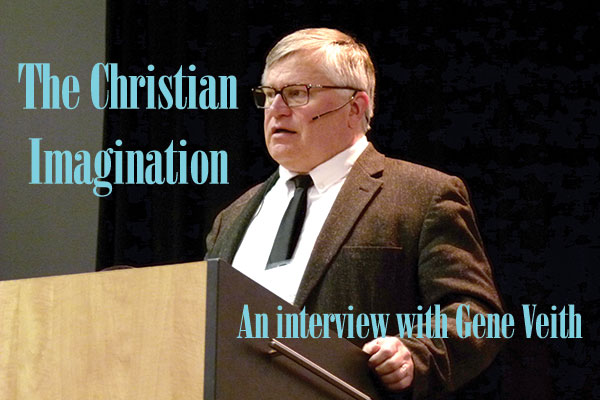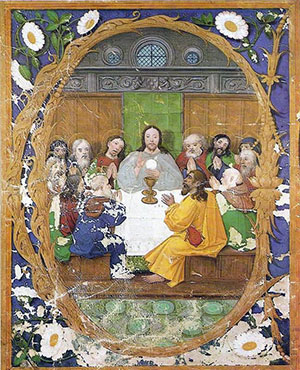The Christian Imagination: An Interview with Gene Veith

Dr. Gene Veith, Provost and Professor of Literature at Patrick Henry College in Virginia, was keynote speaker for the Canadian Centre for Scholarship and the Christian Faith’s third annual conference March 21-22, 2014 at Concordia University College of Alberta in Edmonton. His topic was “The Arts, the Imagination, and the Christian Life.”
Dr. Veith is the author of numerous books, including The Spirituality of the Cross and God at Work: Your Christian Vocation in All of Life. He is also co-author of a forthcoming title on the Christian imagination. Following Dr. Veith’s lectures at the conference, he sat down with Mathew Block, editor of The Canadian Lutheran, for an interview.
CL: In your lectures at the Canadian Centre for Scholarship and the Christian Faith’s 2014 Conference, you spoke about the arts, imagination, and the Christian faith. Briefly, what is imagination?
The imagination is just the human capacity to picture things in our minds. One example is memory: we can remember experiences that we’ve had. Other examples are daydreaming, fantasizing, and planning for the future. Images fall through our minds all the time, and that’s the realm of the imagination: the ability to conjure up mental pictures or images.
I think for much of our waking moments (and even when we sleep and dream), we think in terms of images. Most people look at the mind in terms of the intellect, of reason. That’s certainly important: the ability to understand things. We also might think of emotion, our ability to feel things. These are both facets of the mind. But I think the use of the mind that we use more than any other is the imagination.
CL: Why is the imaginative life important for Christians?
Imagination is important in the life of a Christian because it constitutes so much of our inner-life. We sin in our imaginations. Jesus in the Sermon on the Mount distinguishes between sins we actually do in an outer-way and sins we commit in our hearts. We might not break the commandment against murder literally, but when we murder someone in our hearts—in other words, when we are angry at our neighbours or have contempt for them—then we’re sinning against the commandment [Matthew 5:21-30].
Imagination is also the source of idolatry. Scripture talks about making gods according to the imaginations of the heart [cf. Jeremiah 7:24, 9:14, etc.]. People use their imaginations to make up their own religions, their own theologies. That can clearly lead us away. It’s clear then that we can sin in our imagination. We need to learn how to discipline our imagination, to control and channel it in positive ways.
On the other hand, we’re told in Scripture to ‘weep with those who weep and rejoice with those who rejoice’ [Romans 12:15]. That means putting ourselves into the position of other people and imagining what it would be like to suffer or rejoice with them. Imagination can then have a positive moral effect: it can teach compassion, sympathy, and love for our neighbours.
We’re told in Scripture to ‘weep with those who weep and rejoice with those who rejoice.’ That means putting ourselves into the position of other people and imagining what it would be like to suffer or rejoice with them. Imagination can then have a positive moral effect: it can teach compassion, sympathy, and love for our neighbours.

CL: How do the fine arts—music, literature, the visual arts, and so forth—reflect the imaginative life in a special way?
The imagination is the source of the arts. It’s what allows us to be creative. We all use this creative aspect of the imagination—when we plan ahead for an event, for example, or when we make something in our work or in our different vocations. Artists similarly create out of the imagination. Painters, musicians, writers, even parents just telling a story to their children—all use their imagination to create.
At the same time, those of us who receive their creation also receive it with our imaginations. Let’s go back to the example of parents telling their children a story: when you tell a story, children picture that story and play it in their own little minds. That’s shaping their imaginations. By the same token, the music we listen to, the television we watch, all the different kinds of art we encounter can affect us profoundly because imagination goes very deep inside us.
Art changes you, and it can do so for the good or the bad. If our imagination is saturated with violence, or hyper-sexuality, or nihilism, or darkness, it affects us in a negative way spiritually. By the same token, art that is positive can teach us about the difference between right and wrong. It can teach us about the attractiveness of virtue and can help us to be repelled by things that are evil. More deeply than that, it can help us to understand the Gospel more fully and grow in our faith.
CL: In some branches of Christianity you find people warning about the worldliness of the culture around us. To counter it, they’ve set up a Christian sub-culture where they only listen to Christian music, read Christian fiction, and watch Christian movies. What is the problem with approach?
As Lutherans, we have the Doctrine of the Two Kingdoms. We know God works in the spiritual realm of the Church through the Gospel, but we also believe that God is ruling the secular realm too—that He reigns whether people know it or not. We see that in the laws that He has put into effect. We often speak out natural law and morality, but there are also aesthetic laws God has set up: laws that govern what makes something good and beautiful. God is working in culture. He works in vocation to give His gifts to the world even through those who do not know Him.
Lutherans can therefore have a more positive view of culture than some other churches and theological traditions do. We don’t have to take over the culture or win the culture for Christ; Christ is already the King. We can see His hand at work in culture. For that reason, even something ‘secular’ can speak to Christians when we see it with the eyes of faith.
That doesn’t mean that everything in the culture is to be accepted by Christians. Part of the Doctrine of the Two Kingdoms is that God rules His secular world by means of the moral law. Things that violate the moral law—pornography or the glamorization of adultery for example—are not things that Christians should accept. But at the same time, there are good things in culture. For example, many of the novels of the western world end in marriage. We see God’s law manifesting itself whether readers or even the authors are necessarily aware of it.
The problem with the Christian sub-culture is that it doesn’t actually solve the cultural problem. You can create your own culture but it’s still a culture. And so you’re still going to have the same temptations of the world even in your supposedly Christian sub-culture. They’re not immune from the temptations of the world.
The problem with the Christian sub-culture is that it doesn’t actually solve the cultural problem. You can create your own culture but it’s still a culture. And so you’re still going to have the same temptations of the world even in your supposedly Christian sub-culture. They’re not immune from the temptations of the world.
Christian sub-cultures can also be caustic to faith because they turns Christianity into a cultural religion. Many of the world’s religions are cultural religions, but Christianity is not. It’s not for one little sub-culture; it’s for every tribe, every tongue, every nation under heaven [Revelation 5:9]. But when you have a Christian sub-culture, you can easily start turning that little culture into an idol.
Also, because culture works by law, you can easily end up with a religion of just law. That’s the case with most churches that go in this direction, from the Amish to Protestant Fundamentalists. They’re not immune from the temptations of the world. What’s worse, they sometimes identify this sub-culture with the Kingdom of God. But it’s not the Kingdom of God—that comes from the Gospel, from Christ. The result of living in a Christian sub-culture, as a result, can be real spiritual confusion.
CL: How does God use imagination to address humanity?

A painting of the Last Supper (and institution of Holy Communion) by 16th century artist Francisco de Holanda.
We believe in the Incarnation—that God became flesh. The Second Person of the Trinity became flesh, became a human being and dwelt among us [John 1:14]. God makes Himself tangible. He becomes one of us so that we can know Him. We also believe in His cross—that Jesus came and took into Himself the sins and sorrows of the world. He physically died for them and physically rose from the dead. The central tenet of Christianity then is about something very tangible.
Even in Christian worship, that message is repeated and proclaimed in physical, tangible ways. In the waters of baptism, Christ makes us part of His body. In the bread and wine, we receive His body and His blood. He gives us His Spirit, yes, but He also gives us His body and His blood. These things—water, bread, and wine—are tangible. And as tangible things, they address us in our imagination. It’s understandable then why so much of Christian art draws on the Sacraments. They address our imaginations, and are a means of reaching us on a very deep level.
It’s understandable why so much of Christian art draws on the Sacraments. They address our imaginations, and are a means of reaching us on a very deep level.
CL: Because God relates to people in that way—speaking to us through our imaginations—what does that mean for the Church’s mission of bringing the Gospel to others?
A big reason why so many people today have no religious beliefs at all is, I think, a failure of the contemporary imagination. People cannot even conceive of God. They are closed off from spiritual things because their imaginations have been shaped by a narrow, materialist understanding of the universe—that what we see is all there is. That’s very limiting and it’s stultifying to the imagination. People today in our post-modern world are not open to religion, but it isn’t a matter that they think Christianity has been disproven or that they can’t believe it intellectually—the same people who are skeptical of Christianity are also skeptical of reason! They’re just trapped in their imaginations.
Art can help awaken the imagination to transcendence and to mystery—to open people up to the idea that there’s something more than just their little lives. J.R.R. Tolkien was once defending fantasy from the charge that it’s escapist. He answered by saying, ‘If you’re in prison, it’s healthy to want to escape.’ His point was that people today are imprisoned by their narrow materialistic worldviews.

A painting of God by Cima da Conegliano.
One thing that Christians can do to reach people is to intentionally speak to their imaginations—to give them the intimation that there’s something more than their narrow little lives. To help them realize their need for Christ—to imagine what it means to be lost and what eternal life is.
Many of the obstacles against the Christian faith in people’s minds are really imaginative creations: they think of God as an old man with a beard up in the sky looking down on this suffering world, and they can’t believe that. No one should believe that. God is much bigger than that. We have to explode some of these false impressions that people have and replace them with something more real—to open people up to the real mysteries of existence that point ultimately to God.
Many of the obstacles against the Christian faith in people’s minds are really imaginative creations: they think of God as an old man with a beard up in the sky looking down on this suffering world, and they can’t believe that. No one should believe that. God is much bigger than that.
Just waking up the imagination of someone isn’t enough, of course; we have to get them back into objective truth. But awakening imagination and opening people’s eyes to bigger spiritual realities is very important as a first step. From there, we lead them into the truth of God’s Word.
CL: This ties in to what you and others call ‘imaginative apologetics.’ How does awakening the imagination open people up to the Gospel?
One function of art, it has been said, is to defamiliarize experience. We can become so familiar with things that we stop paying attention to them. Art can cause us to notice them in our lives anew. The same thing happens with faith. For a lot of people, Christianity is ‘old hat’ and easily dismissed. Art can help us defamiliarize Christianity so people see it clearly for the first time.
Art can help create new paradigms of thinking—to undo some of the obstacles people have to faith. People sometimes reject the faith because their imaginative model of it is inaccurate. They base their convictions—or lack of convictions—on an erroneous picture of what Christianity is. A prime example is the problem of evil, the problem of suffering: ‘How can there be a God who allows all this suffering in the world?’ many people ask. Behind this question is the idea that God is distant—that He’s ‘way up there’ looking down on suffering humanity. But Christianity teaches that God actually enters into this realm of sin. In Christ and the cross, God took the evil and suffering of the world into Himself. That’s why Isaiah writes, ‘Surely he has borne our griefs and carried our sorrows’ [Isaiah 53:4].
Many people who reject faith, however, picture God as distant, somewhere up far away. This flawed imaginative model of God is an obstacle to believing in the true God. Christians need to help such people recast their understanding of God—to think of God in Christ. To imagine God in this world. To think of suffering in the context of the cross—of God bearing our suffering. That’s the way we must approach God. Luther makes this very clear: we dare not think of God apart from His coming in the flesh in Christ. Helping people to picture God in this way gives them a completely different paradigm for conceiving of God and the things of God.
CL: Can you give us a practical example of how imaginative apologetics has been done before?

C.S. Lewis.
C.S. Lewis is a great example. He’s mainly known in the 20th century for making a rational case for Christianity. Even so, his writing is filled with description, filled with analogy, filled with an excitement that connects with people and awakens in them the desire to pay attention to and respond to his more rational apologetics.
But Lewis not only wrote books like Mere Christianity and The Problem of Pain; he also wrote works of fantasy: The Chronicles of Narnia, The Space Trilogy, The Screwtape Letters, The Great Divorce, Until we Have Faces, and so on. These are works of the imagination; they appeal to the imagination as all novels do. But they also have an apologetic effect too. These works of fiction have played a role in helping many people understand the Gospel.
Lewis converted to Christianity later in life. But as he himself notes, his father took him to church and he went through Sunday School as a child. He wonders as a result why he didn’t see how mind-blowing and wonderful Christianity is when he was first taught it. Part of the problem, he says, is that it wasn’t taught in a way that addressed the imagination. He marvels how it is possible to make the story of God-becoming-flesh and dying for sinful man so boring. But that’s how it was presented to him as a youth. It took him much later to embrace Christianity.
C.S. Lewis wonders why he didn’t see how mind-blowing and wonderful Christianity is when he was first taught it as a child. Part of the problem, he says, is that it wasn’t taught in a way that addressed the imagination. He marvels how it is possible to make the story of God-becoming-flesh and dying for sinful man so boring. But that’s how it was presented to him as a youth.
For this reason, Lewis says that part of his goal in writing The Lion, the Witch, and the Wardrobe is to present Christian truths through an imaginary world, in the hopes they will steal past the ‘watchful dragons’ of the mind which try to keep out these truths. In this book, Lewis writes about an imaginary world of talking animals where, to save talking animals, God becomes a talking animal. He writes about a Lion who becomes a substitute for a rotten little kid (Edmund) and dies in his place. But the Stone Table breaks and He rises from the dead. He defeats the Witch who has made everything frozen and cold. He’s portraying the Gospel in unfamiliar terms so that it comes as fresh and appeals to the imagination. But at the same time, he’s nevertheless still pointing to the actual Gospel in real life. It’s a great example of imaginative apologetics. Lewis was a master of both rational and imaginative apologetics, and made them work together.
CL: What can people in the church do practically to foster this imaginative way of life and this imaginative way of interacting with the world?
I’ve just written a book with Matthew Ristuccia, a pastor in Princeton, New Jersey, that talks about this sort of thing [book forthcoming from Crossway]. One thing we can do to foster a truly Christian imagination is to reflect on how we read Scripture. The visual arts, film, and music are all important mediums, but it’s really reading that shapes our imagination more than anything else. When we read, we visualize and picture the things we’re reading about; we’re doing the work of imagination in our minds.
God has given us a book that’s filled with description, stories, symbols, images, true history, and parables. We often read Scripture fairly quickly, just to get ideas from it—to extract doctrine from it. But another way of reading Scripture is to read it in a way that really lets it sink in. Part of that is reading it not only with the intellect and will, but also with the imagination. In our forthcoming book, Rev. Ristuccia and I talk about different ways of meditating on the Word of God. It involves the intellect and thinking about what we’re reading, of course, but it also involves picturing what we’re reading. And it also affects the will, so that it ends in prayer and a refocusing of the heart. I think intentionally reading Scriptures so that it feeds the imagination is a good counter to what we normally feed our imaginations with from the pop-culture around us.
Finally, Christians can also be careful about what they take into their imaginations. I think the Christian faith liberates us; we have great freedom in the Gospel. So I’m not saying ‘Only listen to Christian music’ or ‘Only watch Christian movies.’ It’s possible to listen to non-Christian music and watch non-Christian movies through the eyes of faith and through a Christian sensibility and a Christian imagination. When we do so, we can find valuable things. A violent film might make us more compassionate—might make us less violent. But another film might encourage us to revel in the violence—to enjoy it and fantasize about what it would be like to take revenge and kill someone. That’s harmful. As Christians, we need to be better stewards and more discerning about what we take into our imaginations.
As Christians, we need to be better stewards and more discerning about what we take into our imaginations.
A passage from Philippians puts it well: ‘Whatever is true, whatever is honest, whatever is of good report… Think on such things’ (Philippians 4:8). That’s a great guide that gives us principles of discernment. It’s liberating, not narrow either: the key part of the text is ‘whatever.’ Whatever is excellent. There are excellent works by non-Christians that have a good report; they have a great reputation. And typically, the great works are also honest: they will not portray reality in a distorted way, as if sin were something good (you won’t find many great works teaching ‘It’s good to reject your family’). That’s not what you find. The great works are honest. They’re lovely. And St. Paul tells us to ‘think on such things.’ Thinking on such ‘excellent and praiseworthy’ things, imagining such things, is very helpful for the Christian life.
——————–
Mathew Block is editor of The Canadian Lutheran.





